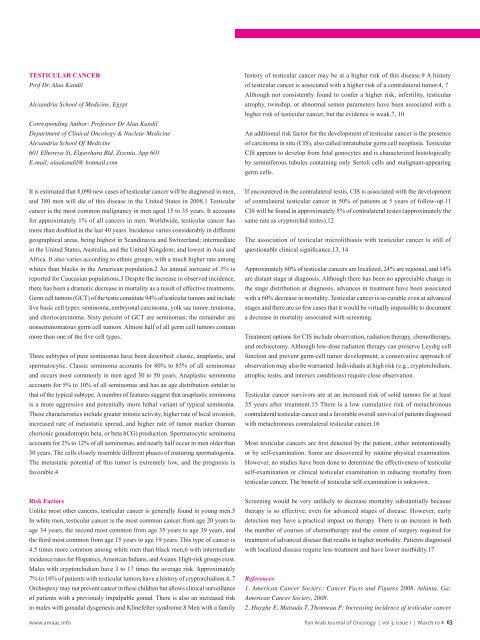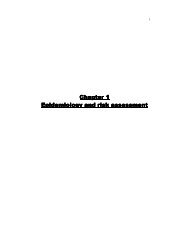Pan Arab Journal of Oncology - Arab Medical Association Against ...
Pan Arab Journal of Oncology - Arab Medical Association Against ...
Pan Arab Journal of Oncology - Arab Medical Association Against ...
You also want an ePaper? Increase the reach of your titles
YUMPU automatically turns print PDFs into web optimized ePapers that Google loves.
TESTICULAR CANCER<br />
Pr<strong>of</strong> Dr. Alaa Kandil<br />
Alexandria School <strong>of</strong> Medicine, Egypt<br />
Corresponding Author: Pr<strong>of</strong>essor Dr Alaa Kandil<br />
Department <strong>of</strong> Clinical <strong>Oncology</strong> & Nuclear Medicine<br />
Alexandria School Of Medicine<br />
601 Elhoreya St, Elgawhara Bld, Zizenia, App 601<br />
E-mail: alaakandil@ hotmail.com<br />
It is estimated that 8,090 new cases <strong>of</strong> testicular cancer will be diagnosed in men,<br />
and 380 men will die <strong>of</strong> this disease in the United States in 2008.1 Testicular<br />
cancer is the most common malignancy in men aged 15 to 35 years. It accounts<br />
for approximately 1% <strong>of</strong> all cancers in men. Worldwide, testicular cancer has<br />
more than doubled in the last 40 years. Incidence varies considerably in different<br />
geographical areas, being highest in Scandinavia and Switzerland; intermediate<br />
in the United States, Australia, and the United Kingdom; and lowest in Asia and<br />
Africa. It also varies according to ethnic groups, with a much higher rate among<br />
whites than blacks in the American population.2 An annual increase <strong>of</strong> 3% is<br />
reported for Caucasian populations.3 Despite the increase in observed incidence,<br />
there has been a dramatic decrease in mortality as a result <strong>of</strong> effective treatments.<br />
Germ cell tumors (GCT) <strong>of</strong> the testis constitute 94% <strong>of</strong> testicular tumors and include<br />
five basic cell types: seminoma, embryonal carcinoma, yolk sac tumor, teratoma,<br />
and choriocarcinoma. Sixty percent <strong>of</strong> GCT are seminomas; the remainder are<br />
nonseminomatous germ cell tumors. Almost half <strong>of</strong> all germ cell tumors contain<br />
more than one <strong>of</strong> the five cell types.<br />
Three subtypes <strong>of</strong> pure seminomas have been described: classic, anaplastic, and<br />
spermatocytic. Classic seminoma accounts for 80% to 85% <strong>of</strong> all seminomas<br />
and occurs most commonly in men aged 30 to 50 years. Anaplastic seminoma<br />
accounts for 5% to 10% <strong>of</strong> all seminomas and has an age distribution similar to<br />
that <strong>of</strong> the typical subtype. A number <strong>of</strong> features suggest that anaplastic seminoma<br />
is a more aggressive and potentially more lethal variant <strong>of</strong> typical seminoma.<br />
These characteristics include greater mitotic activity, higher rate <strong>of</strong> local invasion,<br />
increased rate <strong>of</strong> metastatic spread, and higher rate <strong>of</strong> tumor marker (human<br />
chorionic gonadotropin beta, or beta hCG) production. Spermatocytic seminoma<br />
accounts for 2% to 12% <strong>of</strong> all seminomas, and nearly half occur in men older than<br />
50 years. The cells closely resemble different phases <strong>of</strong> maturing spermatogonia.<br />
The metastatic potential <strong>of</strong> this tumor is extremely low, and the prognosis is<br />
favorable.4<br />
Risk Factors<br />
Unlike most other cancers, testicular cancer is generally found in young men.5<br />
In white men, testicular cancer is the most common cancer from age 20 years to<br />
age 34 years, the second most common from age 35 years to age 39 years, and<br />
the third most common from age 15 years to age 19 years. This type <strong>of</strong> cancer is<br />
4.5 times more common among white men than black men,6 with intermediate<br />
incidence rates for Hispanics, American Indians, and Asians. High-risk groups exist.<br />
Males with cryptorchidism have 3 to 17 times the average risk. Approximately<br />
7% to 10% <strong>of</strong> patients with testicular tumors have a history <strong>of</strong> cryptorchidism.4, 7<br />
Orchiopexy may not prevent cancer in these children but allows clinical surveillance<br />
<strong>of</strong> patients with a previously impalpable gonad. There is also an increased risk<br />
in males with gonadal dysgenesis and Klinefelter syndrome.8 Men with a family<br />
history <strong>of</strong> testicular cancer may be at a higher risk <strong>of</strong> this disease.9 A history<br />
<strong>of</strong> testicular cancer is associated with a higher risk <strong>of</strong> a contralateral tumor.4, 7<br />
Although not consistently found to confer a higher risk, infertility, testicular<br />
atrophy, twinship, or abnormal semen parameters have been associated with a<br />
higher risk <strong>of</strong> testicular cancer, but the evidence is weak.7, 10<br />
An additional risk factor for the development <strong>of</strong> testicular cancer is the presence<br />
<strong>of</strong> carcinoma in situ (CIS), also called intratubular germ cell neoplasia. Testicular<br />
CIS appears to develop from fetal gonocytes and is characterized histologically<br />
by seminiferous tubules containing only Sertoli cells and malignant-appearing<br />
germ cells.<br />
If encountered in the contralateral testis, CIS is associated with the development<br />
<strong>of</strong> contralateral testicular cancer in 50% <strong>of</strong> patients at 5 years <strong>of</strong> follow-up.11<br />
CIS will be found in approximately 5% <strong>of</strong> contralateral testes (approximately the<br />
same rate as cryptorchid testes).12<br />
The association <strong>of</strong> testicular microlithiasis with testicular cancer is still <strong>of</strong><br />
questionable clinical significance.13, 14<br />
Approximately 60% <strong>of</strong> testicular cancers are localized, 24% are regional, and 14%<br />
are distant stage at diagnosis. Although there has been no appreciable change in<br />
the stage distribution at diagnosis, advances in treatment have been associated<br />
with a 60% decrease in mortality. Testicular cancer is so curable even at advanced<br />
stages and there are so few cases that it would be virtually impossible to document<br />
a decrease in mortality associated with screening.<br />
Treatment options for CIS include observation, radiation therapy, chemotherapy,<br />
and orchiectomy. Although low-dose radiation therapy can preserve Leydig cell<br />
function and prevent germ-cell tumor development, a conservative approach <strong>of</strong><br />
observation may also be warranted. Individuals at high risk (e.g., cryptorchidism,<br />
atrophic testis, and intersex conditions) require close observation.<br />
Testicular cancer survivors are at an increased risk <strong>of</strong> solid tumors for at least<br />
35 years after treatment.15 There is a low cumulative risk <strong>of</strong> metachronous<br />
contralateral testicular cancer and a favorable overall survival <strong>of</strong> patients diagnosed<br />
with metachronous contralateral testicular cancer.16<br />
Most testicular cancers are first detected by the patient, either unintentionally<br />
or by self-examination. Some are discovered by routine physical examination.<br />
However, no studies have been done to determine the effectiveness <strong>of</strong> testicular<br />
self-examination or clinical testicular examination in reducing mortality from<br />
testicular cancer. The benefit <strong>of</strong> testicular self-examination is unknown.<br />
Screening would be very unlikely to decrease mortality substantially because<br />
therapy is so effective, even for advanced stages <strong>of</strong> disease. However, early<br />
detection may have a practical impact on therapy. There is an increase in both<br />
the number <strong>of</strong> courses <strong>of</strong> chemotherapy and the extent <strong>of</strong> surgery required for<br />
treatment <strong>of</strong> advanced disease that results in higher morbidity. Patients diagnosed<br />
with localized disease require less treatment and have lower morbidity.17<br />
References<br />
1. American Cancer Society.: Cancer Facts and Figures 2008. Atlanta, Ga:<br />
American Cancer Society, 2008.<br />
2. Huyghe E, Matsuda T, Thonneau P: Increasing incidence <strong>of</strong> testicular cancer<br />
www.amaac.info <strong>Pan</strong> <strong>Arab</strong> <strong>Journal</strong> <strong>of</strong> <strong>Oncology</strong> | vol 3; issue 1 | March 10 < 63









